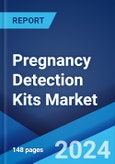Pregnancy detection kits are diagnostics devices used for an early indication of pregnancy. They are manufactured using a lateral flow device (LFD) that contains different types of paper engineered with pores of various sizes. They comprise a test strip that consists of a result window, absorbent paper, and sample well and help detect the presence of reproductive hormones, including human chorionic gonadotropin (HCG), in the samples of urine and blood. They are cost-effective, easy to use, reliable, and provide results in a few minutes. Besides this, as they aid in detecting early pregnancy and promote social and emotional well-being, pregnancy detection kits are gaining traction across the globe. At present, product manufacturers are introducing digital pregnancy detection kits with weeks indicator.
Pregnancy Detection Kits Market Trends:
There is an increase in awareness about the availability of pregnancy detection kits. This, couple with the numerous benefits associated with the early detection of the prenatal period, such as focusing on social and emotional well-being, represents one of the major factors strengthening the growth of the market around the world. Moreover, the growing adolescent pregnancy rate, rising birth rate, and the increasing number of unplanned pregnancies are some of the factors influencing the market positively. In addition, the increasing demand for home-based pregnancy detection kits to reduce the number of hospital visits and minimize healthcare expenses is contributing to the market growth. Apart from this, key players are focusing on promotional strategies, such as celebrity endorsements, banner and television advertisements and marketing in movie theaters to propel people for using pregnancy detection kits, thereby increasing their overall sales. Furthermore, the expansion of pharmacies across residential areas is propelling the growth of the market. Besides this, there is a rise in the number of online retail platforms that offer pregnancy detection kits at affordable rates and with easy accessibility through the comforts of the home. This, in confluence with significant growth in the pharmaceutical and e-commerce industries, is creating a positive outlook for the market. Additionally, rapid urbanization, rising global population, and expanding purchasing power of the consumer are driving the sales of pregnancy detection kits across the globe.Key Market Segmentation:
The publisher provides an analysis of the key trends in each segment of the global pregnancy detection kits market, along with forecasts at the global, regional, and country level from 2024-2032. Our report has categorized the market based on product, test type, and end user.Product Insights:
- Home Pregnancy Tests (HPT)
- Digital Devices
- Others
Test Type Insights:
- Urine Test for HCG
- Blood Test for HCG
- Others
End User Insights:
- Household
- Gynecology Clinics
Hospitals
A detailed breakup and analysis of the pregnancy detection kits market based on the end user has also been provided. This includes household, gynecology clinics and hospitals. According to the report, gynecology clinics accounted for the largest market share.Regional Insights:
- North America
- United States
- Canada
- Asia-Pacific
- China
- Japan
- India
- South Korea
- Australia
- Indonesia
- Others
- Europe
- Germany
- France
- United Kingdom
- Italy
- Spain
- Russia
- Others
- Latin America
- Brazil
- Mexico
- Others
Middle East and Africa
The report has also provided a comprehensive analysis of all the major regional markets that include North America (the United States and Canada), Asia Pacific (China, Japan, India, South Korea, Australia, Indonesia, and others), Europe (Germany, France, United Kingdom, Italy, Spain, Russia, and others), Latin America (Brazil, Mexico, and others), and the Middle East and Africa. According to the report, North America was the largest market for pregnancy detection kits. Some of the factors driving the North America pregnancy detection kits market included increased availability of pregnancy detection kits, high government spending on quality healthcare, and an increase in unplanned pregnancies.Competitive Landscape:
The report has also provided a comprehensive analysis of the competitive landscape in the global pregnancy detection kits market. Detailed profiles of all major companies have also been provided. Some of the companies covered include Abbott Laboratories, Axis Medicare, bioMérieux SA (INSTITUT MERIEUX), Cardinal Health Inc., Church & Dwight Co. Inc., Germaine Laboratories Inc, Mankind Pharma, Piramal Enterprises, QuidelOrtho Corporation, Swiss Precision Diagnostics GmbH (Procter & Gamble Company), etc. Kindly note that this only represents a partial list of companies, and the complete list has been provided in the report.Key Questions Answered in This Report:
- How has the global pregnancy detection kits market performed so far and how will it perform in the coming years?
- What are the drivers, restraints, and opportunities in the global pregnancy detection kits market?
- What are the key regional markets?
- Which countries represent the most attractive pregnancy detection kits markets?
- What is the breakup of the market based on the product?
- What is the breakup of the market based on the test type?
- What is the breakup of the market based on the end user?
- What is the competitive structure of the global pregnancy detection kits market?
- Who are the key players/companies in the global pregnancy detection kits market?
Table of Contents
Companies Mentioned
- Abbott Laboratories
- Axis Medicare
- bioMérieux SA (INSTITUT MERIEUX)
- Cardinal Health Inc.
- Church & Dwight Co. Inc.
- Germaine Laboratories Inc
- Mankind Pharma
- Piramal Enterprises
- QuidelOrtho Corporation
- Swiss Precision Diagnostics GmbH (Procter & Gamble Company)
Methodology

LOADING...
Table Information
| Report Attribute | Details |
|---|---|
| No. of Pages | 148 |
| Published | March 2024 |
| Forecast Period | 2023 - 2032 |
| Estimated Market Value ( US$ | US$ 1.5 Billion |
| Forecasted Market Value ( US$ | US$ 2.5 Billion |
| Compound Annual Growth Rate | 5.8% |
| Regions Covered | Global |
| No. of Companies Mentioned | 10 |









